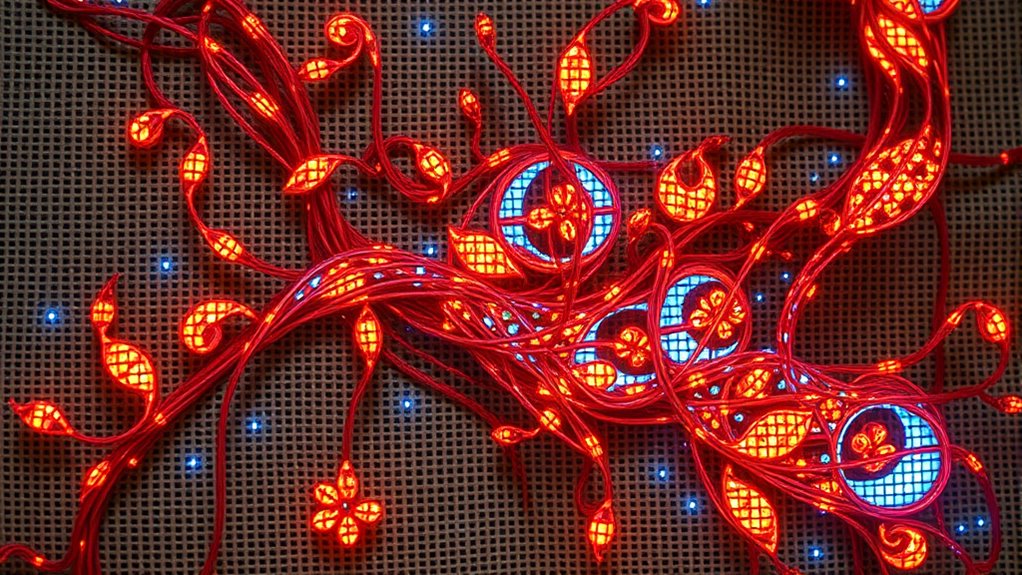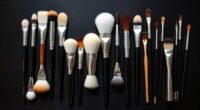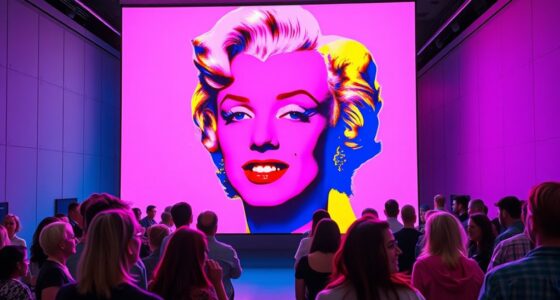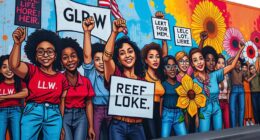Hybrid aesthetics blend traditional handcrafted art with digital techniques to push creative boundaries and reflect cultural influences. You can combine old-school methods with modern tools like 3D modeling, digital printing, or augmented reality, enriching your work with both texture and innovation. This fusion opens new opportunities for unique collaboration, storytelling, and audience engagement. Exploring this exciting space allows you to create visually striking, meaningful art that celebrates tradition while embracing progress—learn more about how to start your own hybrid journey.
Key Takeaways
- Artists merge traditional craftsmanship with digital tools to create innovative, textured, and interactive hybrid artworks.
- Techniques like combining handcrafted textures with 3D modeling enhance visual depth and emotional resonance.
- Cultural symbolism integrates seamlessly with digital processes, preserving heritage while embracing technological advancements.
- Digital-manual workflows facilitate collaborative projects, expanding creative possibilities across distances and disciplines.
- Future trends focus on sustainable, smart materials and personalized experiences within hybrid aesthetic practices.
The Evolution of Artistic Boundaries

The boundaries of art have continuously shifted, reflecting society’s changing values and technological advancements. Cultural influences play a significant role in shaping what’s considered art and how it’s appreciated. Over time, different societies have embraced diverse styles, techniques, and materials, expanding the scope of creative expression. The historical context provides insight into these changes, revealing how movements like the Renaissance, Modernism, or Digital Art emerged from specific societal needs and technological breakthroughs. You can see how traditional forms evolved when new tools or ideas arrived, breaking old limits and redefining aesthetics. These shifts allow you to understand that art isn’t static—it’s a dynamic reflection of cultural evolution, constantly adapting to the world around it.
Techniques Merging Tradition and Innovation

As artists push the boundaries of traditional art forms, they often blend time-honored techniques with cutting-edge innovations to create fresh visual experiences. You might combine centuries-old cultural symbolism with digital tools, transforming material textures into immersive narratives. This fusion allows for expressive depth, connecting past and present seamlessly. By merging craftsmanship with technology, you evoke emotional resonance and challenge perceptions. For example, a textured canvas layered with digital enhancements can evoke nostalgia or curiosity. Consider this table, illustrating the synergy:
| Tradition | Innovation | Result |
|---|---|---|
| Cultural symbolism | Digital manipulation | Deepened meaning |
| Handcrafted textures | 3D printing | Tactile engagement |
| Classical motifs | Augmented reality | Interactive storytelling |
Additionally, understanding the regulations and compliance surrounding digital art integration ensures that creators operate within legal frameworks while exploring new artistic frontiers. Incorporating payment processing best practices can facilitate secure transactions for art sales and collaborations, supporting artists’ financial sustainability. Recognizing the importance of copyright laws helps protect artists’ original work in this evolving digital landscape. Exploring digital art tools can further enhance creative possibilities and expand artistic horizons. Moreover, considering cost management strategies can help artists optimize resources and maintain profitability in their innovative pursuits.
Case Studies: Successful Hybrid Creations

You can see how notable artistic collaborations blend different styles to create fresh visuals that captivate audiences. These projects often combine innovative digital techniques with traditional manual craftsmanship, pushing creative boundaries. Exploring successful hybrid creations reveals how merging diverse approaches leads to striking, memorable works. Incorporating practical guidance ensures that artists can seamlessly integrate traditional and digital methods for optimal results. Additionally, understanding color accuracy and its impact on image quality can inspire new ways to fuse art forms across disciplines. Moreover, embracing networking within the artistic community can open opportunities for collaborative hybrid projects, fostering innovation and expanding creative horizons. To facilitate smooth integration, artists should also consider file formats that support high-quality digital outputs and compatibility with traditional media.
Notable Artistic Collaborations
Bridging different artistic worlds often results in groundbreaking creations that captivate audiences and challenge traditional boundaries. Notable collaborations bring together diverse talents, blending handcrafted techniques with digital innovation to produce compelling hybrid works. These partnerships often explore cultural symbolism, infusing pieces with deep meaning rooted in specific traditions or histories. For example, artists have combined traditional textile motifs with digital printing to preserve cultural identity while embracing modern aesthetics. Such collaborations also reflect varied aesthetic philosophies, balancing craftsmanship with technological advancement. By working across disciplines, these projects demonstrate how merging manual and digital methods can create hybrid aesthetics that resonate with contemporary audiences. These innovative approaches often incorporate natural materials to enhance authenticity and tactile appeal. Integrating modern design principles with traditional craftsmanship further enriches the visual narrative, allowing for a dynamic fusion of old and new. Additionally, embracing remote hackathons can facilitate cross-disciplinary collaboration, expanding the potential for innovative hybrid art projects. Moreover, understanding the importance of sustainable practices in art production can help ensure these hybrid creations are environmentally conscious and ethically produced. As a result, audiences experience art that is both rooted in tradition and forward-looking, highlighting the potential of hybrid aesthetics to redefine artistic boundaries.
Innovative Digital-Manual Fusion
Have you ever wondered how digital tools can enhance manual artistry to create striking, innovative works? Successful hybrid creations seamlessly blend traditional craftsmanship with technology, amplifying cultural symbolism and emotional expression. Take a sculpture that uses 3D modeling to refine intricate details, then employs hand-painting to add emotional depth. These projects often combine digital precision with handcrafted imperfections, enriching the piece’s narrative. Incorporating techniques like yoga styles demonstrates how intentional blending of methods can elevate artistic projects. Additionally, integrating elements of meditation can foster a deeper connection between the artist’s inner experience and the physical creation, resulting in more meaningful artwork. Developing attention during the creative process allows artists to achieve greater harmony between digital and manual techniques. Understanding the weight of wind turbine blades offers insights into how combining different materials and methods can impact the final structure, paralleling the importance of blending techniques in art.
Tools and Software Enabling Hybrid Work

You can leverage digital drawing platforms, 3D modeling tools, and hybrid workflow software to streamline your creative process. These tools allow you to work seamlessly across different formats and collaborate in real-time. Embracing them helps you open new possibilities in hybrid aesthetics. Incorporating automated testing practices into your workflow can also help maintain consistent quality and efficiency as you experiment with different techniques.
Digital Drawing Platforms
Digital drawing platforms have revolutionized the way artists collaborate and create across distances, making hybrid work more seamless than ever. These platforms often feature intuitive user interfaces that streamline your workflow, allowing you to focus on your art rather than technical hurdles. Many tools include interactive tutorials that help you learn new techniques or software features quickly, fostering continuous growth. With real-time sharing and cloud storage, you can easily collaborate with others, receive feedback, or integrate handcrafted elements into digital projects. The accessibility and versatility of these platforms empower you to blend traditional and digital methods effortlessly, expanding your creative possibilities. Whether you’re sketching, coloring, or refining, digital drawing platforms serve as essential bridges between handcrafted artistry and modern digital techniques.
3D Modeling Tools
D modeling tools have become essential for artists and designers seeking to create complex forms and detailed structures seamlessly across hybrid work environments. These tools allow you to manipulate meshes with precision, enabling intricate designs and refined details. Texture mapping becomes more efficient, helping you apply realistic surface qualities and intricate patterns to your models. Mesh optimization features help you reduce polygon counts without sacrificing detail, making models more manageable and improving performance in workflows. With intuitive interfaces, you can seamlessly switch between handcrafted adjustments and digital refinements. This combination empowers you to craft highly detailed, organic forms while maintaining flexibility and efficiency. Ultimately, these tools bridge the gap between traditional craftsmanship and digital precision, fostering innovative hybrid aesthetics.
Hybrid Workflow Software
Hybrid workflow software integrates various modeling, rendering, and collaboration tools into unified platforms, streamlining the creative process across different environments. It enables you to seamlessly switch between handcrafted techniques and digital methods, often through interactive interfaces that foster real-time feedback. Augmented reality features let you visualize designs in physical space, enhancing accuracy and immersion. Imagine:
- An intuitive interface that combines traditional sketching with digital modeling
- Real-time collaboration tools allowing multiple artists to work simultaneously
- Augmented reality overlays to preview how a piece fits into its environment
- Cross-platform compatibility, ensuring your project flows smoothly from desktop to mobile devices
This integration empowers you to blend handcrafted aesthetics with digital precision, fostering innovative hybrid creations that elevate your artistic process.
Challenges and Opportunities in Hybrid Art

While hybrid art offers exciting opportunities to blend diverse mediums and challenge traditional boundaries, it also presents unique challenges that artists and institutions must navigate. Cultural implications come into play as hybrid works push cultural norms and question definitions of authenticity and originality. This can spark debate or resistance within certain communities. Economically, hybrid art can disrupt traditional markets, requiring new strategies for monetization and distribution. You might find that the costs of acquiring digital tools and maintaining technological infrastructure strain budgets. Additionally, intellectual property issues become more complex with blending handcrafted and digital elements. Despite these challenges, hybrid art opens opportunities for innovative collaborations, expanding audiences and creating fresh revenue streams. Embracing these challenges can position you at the forefront of a dynamic and evolving artistic landscape.
Future Trends in Hybrid Aesthetic Design

Emerging technology and shifting cultural perceptions are shaping the future of hybrid aesthetic design. You’ll see material innovation push boundaries, blending traditional textures with advanced composites for unique visual effects. Cultural influences will continue to inspire designers, integrating diverse symbols and practices into digital workflows.
Here are four key trends to watch:
- Smart Materials – Responsive surfaces that adapt to environment and user interaction.
- Cultural Fusion – Incorporating global motifs to create more inclusive designs.
- Sustainable Practices – Using eco-friendly, durable materials to reduce environmental impact.
- Personalization – Leveraging digital tools for tailored, handcrafted experiences.
These trends will deepen the connection between handcrafted artistry and digital innovation, shaping a dynamic hybrid aesthetic future.
Frequently Asked Questions
How Do Hybrid Aesthetics Influence Contemporary Art Market Values?
Hybrid aesthetics markedly influence contemporary art market values by shaping collecting trends and boosting market valuation. You’ll notice collectors increasingly value artworks that blend handcrafted techniques with digital elements, seeing them as innovative and versatile. This fusion often elevates an artwork’s desirability, driving up prices and making pieces more appealing to a broader audience. As hybrid art gains popularity, market valuation continues to grow, reflecting its rising importance in today’s dynamic art scene.
Can Hybrid Art Techniques Be Easily Taught to Beginners?
Yes, you can learn hybrid art techniques as a beginner, but expect a moderate learning curve. It’s important to explore diverse instructional methods like online tutorials, workshops, and hands-on practice. These approaches help you grasp both handcrafted and digital skills effectively. Stay patient and consistent, and you’ll find that blending traditional and digital techniques becomes easier over time, opening up new creative possibilities.
What Ethical Considerations Arise With Digital Manipulation of Traditional Art?
You might think digital manipulation of traditional art is harmless fun, but it raises serious authenticity concerns. When you alter or enhance a piece digitally, you risk eroding the original artist’s intent and misleading viewers about its origins. Plus, intellectual property issues come into play—who owns the new creation? Balancing innovation with respect for the art’s integrity becomes a delicate, ethically charged dance.
How Do Hybrid Art Forms Impact Cultural Preservation?
You might find that hybrid art forms strengthen cultural identity by merging traditional techniques with modern digital tools, making cultures more accessible and relevant. However, you also face preservation challenges, as digital manipulation can sometimes dilute authentic cultural expressions or lead to misinterpretation. By carefully balancing innovation with respect for tradition, you can guarantee that cultural heritage remains vibrant while embracing contemporary artistic practices.
Are There Specific Genres More Suited to Hybrid Artistic Approaches?
Imagine genres as rivers merging into a powerful ocean—certain ones, like digital illustration, mixed media, and interactive art, are especially suited to hybrid approaches. You’ll find genre fusion thrives here because of technique versatility, allowing you to blend traditional craftsmanship with digital innovation seamlessly. These genres invite experimentation, making them ideal for artists enthusiastic to push boundaries and create dynamic, multi-layered works that captivate diverse audiences.
Conclusion
As you explore hybrid aesthetics, remember that over 60% of artists now blend traditional and digital techniques to create innovative works. This fusion not only expands your creative possibilities but also pushes artistic boundaries. Embrace the challenges and leverage new tools to stay ahead in this evolving field. By combining handcrafted art with digital innovation, you’re shaping the future of visual expression—so keep experimenting and redefining what art can be.









